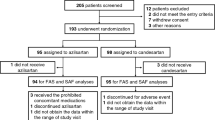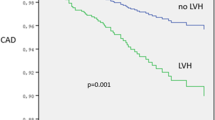Abstract
The aim of the study was to evaluate hypertension treatment effects on mechanical efficiency of the cardiovascular system and cardiac reverse remodeling in hypertensive patients. This is an observational prospective study, consecutive hypertension patients. Left ventricle mass index measured by Devereux 2D method and diastolic function following the Guidelines from the American Society of Echocardiography and the European Association of Cardiovascular Imaging. Left ventricular end systolic elastance (Ees) was measured by Guarracino calculator, the effective arterial elastance (Ea) and ventricular-arterial coupling (VAC) measured by Sunagawa et al. single beat method adapted by Chen et al. in human ventricles. The sample was analyzed in quartiles (Q) according to VAC. Follow-up 2 years. In total, 288 patients, mean age 56.3 ± 12.5 years and 168 patients (58.3%) males. VAC increased from 0.303 ± 0.07 to 0.54 ± 0.25 (p < 0.005) in Q1 mainly due to a reduction in Ees from 5.25 ± 2.3 to 3.68 ± 0.25 mmHg/ml (p < 0.01), while Ea increased from 1.5 ± 0.53 to 1.64 ± 0.56 mmHg/ml (p = NS). The frequency of LVH was reduced from 31.9 to 10.8% in Q1 (p < 0.025). The frequency of normal diastolic function increased from 75 to 94.6% (p < 0.01) in Q1, from 78.7 to 100% in Q2 (p < 0.005), from 87.1 to 100% (p < 0.025) in Q3 and from 88.7 to 100% (0,025) in Q4. Patients with the worst ventricular-arterial uncoupling were the most benefited from hypertension treatment. Regression of left ventricular hypertrophy was observed only in the group of patients with the worst ventricular-arterial uncoupling, while improvement in diastolic function was demonstrated in all quartiles of patients.
This is a preview of subscription content, access via your institution
Access options
Subscribe to this journal
Receive 12 print issues and online access
$259.00 per year
only $21.58 per issue
Buy this article
- Purchase on Springer Link
- Instant access to full article PDF
Prices may be subject to local taxes which are calculated during checkout


Similar content being viewed by others
References
Piskorz D, Keller L, Citta L, Mata L, Citta N, Bongarzoni L, et al. Ventricular-arterial uncoupling and hypertension mediated diastolic dysfunction. High Blood Press Cardiovasc Prev. 2022;29:361–6.
Kameyama T, Asanoi H, Ishizaka S, Yamanishi K, Fujita M, Sasayama S. Energy conversion efficiency in human left ventricle. Circulation. 1992;85:988–96.
Vasan RS, Xanthakis V, Lyass A, Andersson C, Tsao C, Cheng S, et al. Epidemiology of left ventricular systolic dysfunction and heart failure in the Framingham study: an echocardiographic study over 3 decades. JACC Cardiovasc Imaging. 2018;11:1–11.
Pieske B, Tschöpe C, de Boer RA, Fraser AG, Anker SD, Donal E, et al. How to diagnose heart failure with preserved ejection fraction: the HFA-PEFF diagnostic algorithm: a consensus recommendation from the Heart Failure Association (HFA) of the European Society of Cardiology (ESC). Eur Heart J. 2019;40:3297–317.
Tissera G, Piskorz D, Citta L, Citta N, Citta P, Keller L, et al. Morphologic and functional heart abnormalities associated to high modified Tei index in hypertensive patients. High Blood Press Cardiovasc Prev. 2016;23:373–80.
Piskorz D, Keller L, Citta L, Mata L, Citta N, Bongarzoni L, et al. Medium to long term follow-up of treated hypertensive mediated heart disease. High Blood Press Cardiovasc Prev. 2021;28:383–91.
Monosilio S, Filomena D, Luongo F, Sannino M, Cimino S, Neccia M, et al. Cardiac and vascular remodeling after 6 months of therapy with sacubitril/valsartan: mechanistic insights from advanced echocardiographic analysis. Front Cardiovasc Med. 2022;9:883769.
Wang Y, Zhou R, Lu C, Chen Q, Xu T, Li D. Effects of the angiotensin-receptor neprilysin inhibitor on cardiac reverse remodeling: meta-analysis. J Am Heart Assoc. 2019;8:e012272.
Williams B, Mancia G, Spiering W, Agabiti Rosei E, Azizi M, Burnier M, et al. 2018 ESH/ESC guidelines for the management of arterial hypertension. The Task Force for the management of arterial hypertension of the European Society of Hypertension (ESH) and of the European Society of Cardiology (ESC). J Hypertens. 2018;36:1953–2041.
Lang RM, Bierig M, Devereux RB, Flachskampf FA, Foster E, Pellikka PA, et al. Recommendations for chamber quantification. Eur J Echocardiogr. 2006;7:79–108.
Nagueh SF, Smiseth OA, Appleton CP, Byrd BF 3rd, Dokainish H, Edvardsen T, et al. Recommendations for the evaluation of left ventricular diastolic function by echocardiography: an update from the American Society of Echocardiography and the European Association of Cardiovascular Imaging. J Am Soc Echocardiogr. 2016;29:277–314.
Sunagawa K, Maughan WL, Burkhoff D, Sagawa K. Left ventricular interaction with arterial load studied in isolated canine ventricle. Am J Physiol. 1983;245:H773–80.
Chen CH, Fetics B, Nevo E, Rochitte CE, Chiou KR, Ding P, et al. Noninvasive single-beat determination of left ventricular end-systolic elastance in humans. J Am Coll Cardiol. 2001;38:2028–34.
Guarracino F, Baldassarri R, Pinsky MR. Ventriculo-arterial decoupling in acutely altered hemodynamic states. Crit Care. 2013;17:213.
Sagawa K, Suga H, Shoukas AA, Bakalar KM. End-systolic pressure volume ratio: a new index of ventricular contractility. Am J Cardiol. 1977;40:748–53.
Lam CSPM, Shah AM, Borlaug BA, Cheng S, Verma A, Izzo J, et al. Effect of antihypertensive therapy on ventricular–arterial mechanics, coupling, and efficiency. Eur Heart J. 2013;34:676–83.
Osranek M, Eisenach JH, Khandheria BK, Chandrasekaran K, Seward JB, Belohlavek M. Arterioventricular coupling and ventricular efficiency after antihypertensive therapy: a noninvasive prospective study. Hypertension. 2008;51:275–81.
De Tombe PP, Jones S, Burkhoff D, Hunter WC, Kass DA. Ventricular stroke work and efficiency both remain nearly optimal despite altered vascular loading. Am J Physiol. 1993;264:1817–24.
Han JC, Tran K, Crossman DJ, Curl CL, Koutsifeli P, Neale JPH, et al. Cardiac mechanical efficiency is preserved in primary cardiac hypertrophy despite impaired mechanical function. J Gen Physiol. 2021;153:e202012841.
Chantler PD, Lakatta EG. Arterial-ventricular coupling with aging and disease. Front Physiol. 2012;3:90.
Burkhoff D. Pressure-volume loops in clinical research: a contemporary view. J Am Coll Cardiol. 2013;62:1173–6.
Author information
Authors and Affiliations
Corresponding author
Ethics declarations
Conflict of interest
The authors declare no competing interests.
Additional information
Publisher’s note Springer Nature remains neutral with regard to jurisdictional claims in published maps and institutional affiliations.
Rights and permissions
Springer Nature or its licensor holds exclusive rights to this article under a publishing agreement with the author(s) or other rightsholder(s); author self-archiving of the accepted manuscript version of this article is solely governed by the terms of such publishing agreement and applicable law.
About this article
Cite this article
Piskorz, D., Keller, L., Citta, L. et al. Diastolic dysfunction, hypertrophy and hypertension ventricular-arterial uncoupling treatment. Hypertens Res 46, 136–143 (2023). https://doi.org/10.1038/s41440-022-01063-3
Received:
Revised:
Accepted:
Published:
Issue Date:
DOI: https://doi.org/10.1038/s41440-022-01063-3



